General Terms
A
Aberration Deviation from what is normal, right, or natural. In optics, defects of a lens system that cause its image to deviate from the rules of paraxial imagery.
Absorption The loss of light as it passes through a material, generally due to its conversion to other energy forms (usually heat).
Achromatic Free of color; a color perceived to have no hue, such as neutral grays.
Acousto-optics The study of the interactions between sound waves and light in a solid medium.
Afocal An optical system with object and image points at infinity. Literally a system without focal length.
Amorphous The disordered, glassy solid state of a substance, as distinguished from the highly ordered crystalline solid state.
Amplification See Gain.
Angle of incidence The angle formed between a ray of light striking a surface and the normal to that surface at the point of incidence.
Angle of incidence
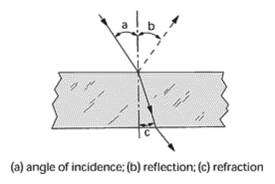
Angle of reflection The angle formed between the normal to a surface and the reflected ray. This angle lies in a common plane with the angle of incidence, and is equal to it.
Angle of refraction The angle formed between the reflected ray and the normal to the surface. This angle lies in a common plane with the angle of incidence.
Angstrom - A unit of distance corresponding to 10-10 m. One angstrom (Ε) is 0.1 nm so that 200 nm corresponds to 2000 Ε.
Antisolar point - The point where an imaginary ray connecting the sun and yourself meets the sky. If the sun is above the horizon, the antisolar point is below the horizon. If the sun is setting in the west, the antisolar point is on the eastern horizon. If the sun is below the horizon, the antisolar point is above the horizon on the other side of the sky.
Aperture An opening or hole through which radiation or mater may pass.
Aperture stop A physical restraint that limits the diameter of the bundle of light allowed to pass through a lens, shown below by "a."
Aperture stop
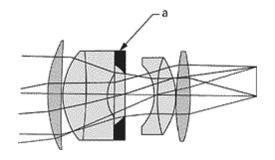
Aplanatic A lens corrected for spherical aberration and coma.
Apodization The use of a variable transmission filter at the aperture stop of a lens to modify its diffraction pattern. Reduced transmission favors performance at high frequencies while reduced transmission favors low frequency performance.
Aspheric Not spherical; an element having one or more surfaces that are not spherical.
Astigmatism A lens aberration that results in the vertical and horizontal image planes being spread to form lines instead of points.
Atomic number - The number of protons in an atomic nucleus. For a neutral atom, this also corresponds to the number of electrons orbiting the nucleus. This number also denotes an atom's place on the Periodic Table of the Elements and the Chart of Nuclides. Carbon has an atomic number of 6: 6 protons and 6 electrons.
Attenuation The loss of optical power.
Axis A straight line passing through a body and indicating its center.
B
Back focal length The distance from the last surface of a lens to its image plane.
Back focal length
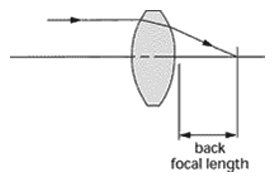
Baffle An opaque shielding device designed to reduce the effects of stray light on an optical system.
Beam 1) A bundle of light rays. 2) A concentrated unidirectional stream of particles. 3) A concentrated unidirectional flow of electromagnetic waves.
Beamsplitter An optical device for dividing a beam into two or more separate beams.
Beamsplitter
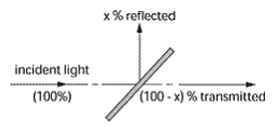
Bifocal A two-part lens that has a different focal length for each part. Used in eyeglasses to correct for near and far vision.
Binocular An instrument having a pair of decentered lenses, one for each eye that focuses on a single object as a magnifier.
Biocular A term pertaining to devices designed for use with both eyes viewing through a single element.
Biocular
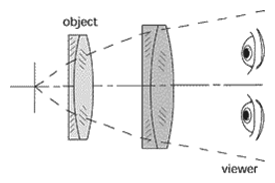
Birefringence The separation of a light beam as it penetrates a doubly refracting object into the ordinary and extraordinary beams.
Birefringence
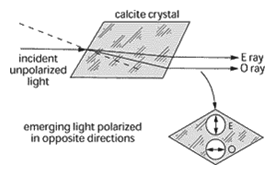
Bore a central hole running the length of a waveguide or laser tube.
C
Camera A light-tight box that receives light from an object or scene and focuses it to form an image on a light-sensitive material or a detector.
Catoptric system An optical system in which the only image-forming elements are curved-surface mirrors.
Cavity The optical resonator in a laser formed by two coaxial mirrors, one totally reflective and the other partially reflective, positioned such that oscillations occur.
Center of curvature The center of the sphere of which the surface of a lens or mirror forms a portion.
Chief ray The ray that passes through the center of an aperture stop in an optical system.
Chief ray
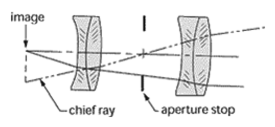
Chromatic Having color.
Chromatic aberration The lens aberration resulting from the normal increase in refractive index of all common materials toward the blue end of the spectrum.
Cladding The low-refractive-index material that surrounds the core of an optical fiber to contain core light while protecting against surface contaminant scattering.
Clear aperture The opening of an optical system, or its components, which limits the extent of the bundle of rays on the given surface. Is usually circular and specified by its diameter.
Coherence length The length over which energy in two separate waves remains constant.
Cold mirror A mirror whose coating reflects only visible radiation while transmitting the infrared.
Collimation The process by which a divergent beam of radiation or particles is converted into a parallel beam.
Color The hue, saturation and brightness that is visibly detectable.
Coma A lens aberration resulting form different magnifications in the various lens zones.
Concave A hollow curved surface; curved inward.
Concentric Characterized by having the same center.
Condenser A single positive lens or group of lenses in a projection system that collect light and cause it to be evenly distributed.
Confocal Elements whose focal points coincide.
Conjugates Light emitted from one element is focused on the other and vice versa.
Contrast The apparent difference in brightness between light and dark areas of an image.
Convergence The bending of light rays toward each other.
Convex Spherically shaped; curves outward.
Core The light-conduction portion of an optical fiber, defined by the region of high refractive index.
Critical angle The smallest angle of incidence at which total internal reflection occurs. When the critical angle is exceeded, the light is totally reflected back into the denser medium. The critical angle will vary with the indices of refraction of the two media: sin(Icrit)=n/n and is shown below by c.
Critical angle
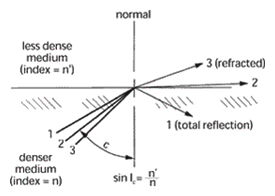
Curvature The measure of departure from a flat surface, as applied to lenses; the reciprocal of radius.
D
Decibel (dB) The standard unit used to express gain or loss and relative power levels. DB = 10 log (P2/P1).
Deflection Any bending of a wave of radiation away from its expected path.
Diffraction - As a wavefront passes by an opaque edge or through an opening, weaker secondary wavefronts are generated that appear to originate at the edge. These wavefronts interfere with the original wavefront as well as each other to form diffraction patterns.
Diffraction
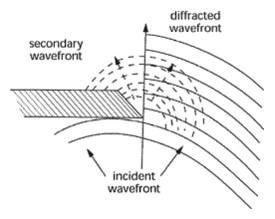
Diffraction grating A device used to break light into its component wavelengths. It usually composed of a material with tiny grooves cut into it which disperses the light as it passes through or bounces off the grating (depending on the type of grating). Physicists and astronomers often use diffraction gratings to study the nature of light.
Diffusion The scattering of light by reflection or transmission. Diffuse reflection results when light strikes an irregular surface such as a frosted window or the surface of a frosted or coated light bulb.
Diffusion

Diopter (D) A unit of optical power that expresses the refractive power of a lens or prism.
Direct ray A ray that travels without being reflected or refracted.
Dispersion The separation of a beam into its various wavelength components.
Distortion The situation where an image is not a true-to-scale reproduction of an object.
Divergence The bending of rays away from each other.
Diverging lens A lens that causes parallel rays of light to spread out. Examples include: negative lens, divergent lens, concave lens, or dispersive lens.
Diverging lens
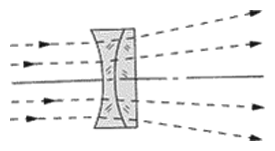
Doppler effect Radiation emitted from a source that moves away from an observer appears to be of lower frequency than the radiation emitted from a stationary source.
Doublet A compound lens consisting of two elements.
E
Edge The surface that limits the aperture of a lens or prism.
Electro-optic effect The change in the refractive index of a material under the influence of an electric field.
Electromagnetic force - One of the four fundamental forces in nature. Refers to the combination of two separate forces -- the electric force and the magnetic force. EM forces act on objects with electric charges and/or magnetic fields. See also electron.
Electromagnetic spectrum The total range of wavelengths that can be generated physically. The range extends from practically zero to infinity and includes the visible portion of the spectrum known as light.
Electromagnetic spectrum
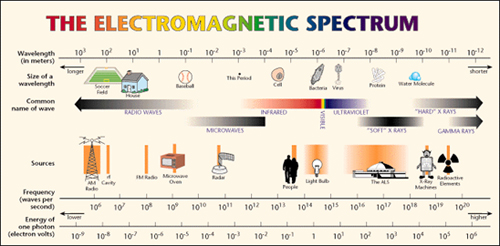
Electron One of the elementary particles of nature. The electron has a charge of -1.6 x 10-19 Coulombs and a mass of 9.1 x 10-31 kg. Electrons orbit the nuclei of atoms and are the principle tool of molecular bonding.
Electroscope - A device that enables you to determine if two objects have opposite or like charges.
Emission spectrum The spectrum formed by radiation from an emitting source.
Emitter A source of radiation.
Etalon Two flat glass surfaces separated by a spacer, with the inner surfaces of the plates coated with a partially reflecting layer.
Exit pupil The image of the aperture stop as seen from image space in an optical system.
Eye The organ of vision or light sensitivity.
Eyepiece The lens system between the final real image on a visual optical system and the eye. Often seen in microscopes.
F
Fabry-Perot interferometer A multiple beam interferometer, usually consisting of two flat plates with high reflective ability. The plates are parallel to each other so light can bounce back and forth several times.
Fabry-Perot interferometer

Fermats principle Light will take the path that requires the least transit time.
Fiber see Optical fiber.
Field of View The maximum area that can be seen through a lens or an optical instrument.
Field stop An aperture located at an image plane of an optical system that determines the size and shape of the image.
Filter A device that attenuates particular wavelengths or frequencies while transmitting others with little change.
Fizeau interferometer A type of interferometer noted for producing narrow multiple-beam interference fringes. As a result, when compared with the Twyman-Green, the Fizeau interferometer has fewer optical components, does not have the large beamsplitter and can be adjusted to a greater accuracy.
Fizeau interferometer
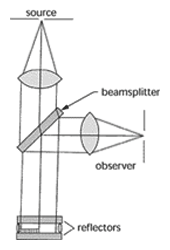
Fluorescence The emission of light or other electromagnetic radiation of longer wavelengths by a substance as a result of the absorption of some other radiation.
F number (f/#) The expression denoting the ratio of the equivalent focal length of a lens to the diameter of the entrance pupil.
Focal Length - The distance from a lens or mirror to its focal point.
Focal length (f) The effective focal length (EFL) is the distance from the principal point of focal point. The back focal length (BFL) is the distance from the vertex of the last lens to the second focal point. The front focal length (FFL) is the distance from the first lens surface to the first focal point.
Focal length (f)
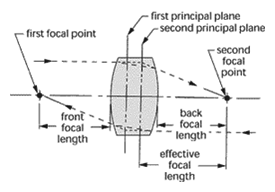
Focal plane The plane on which the best focus is formed.
Focal point The point on the optical axis of a lens, to which an incident bundle of parallel rays will converge.
Focus 1) The focal point. 2) To adjust the eyepiece or objective so that the image is clearly seen.
Fraunhoffer diffraction The diffraction pattern of a source observed at an infinite distance from the source. Far field diffraction.
Fresnel diffraction - Near field diffraction. The diffraction obtained when the source or the observing screen are a finite distance from the diffraction aperture or obstacle.
Fringe An interference band.
Fundamental mode The lowest order mode (lowest energy) of a waveguide.
Fused silica Glass made of pure silicon dioxide (Si02).
G
Gain The increase in a signal that is transmitted from one point to another.
Gaussian beam A beam of light whose electrical field amplitude distribution is Gaussian. A circular cross section amplitude may be expressed as: E(r) = E(0)exp[-(r/w)^2] where r is the distance from the beam center and w is the radius at which the amplitude is 1/e of its value on the axis; w is called the beam width.
Geometric optics A filed of physics that deals with light as if it truly were composed of rays diverging in various directions from the source and are abruptly bent or turned by refraction or reflection.
Glass A noncrystalline, inorganic mixture of various metallic oxides fused by heating with glassifiers such as silica.
Grating A framework or latticework having an even arrangement of rods or long narrow objects used to disperse light by interference.
Grinding The process in optical system manufacturing that gives an element its required shape.
H
Hologram An interference pattern that is recorded on a high-resolution plate, the two interfering beams formed by a coherent beam from a laser and light scattered by an object. After formation, if lit and viewed correctly, a 3-D image of the object is seen.
Hologram
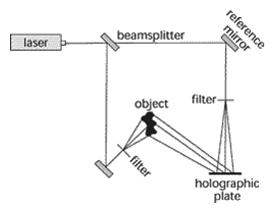
Homogeneous A property of substance that is the same in all directions.
I
Illumination The application of light to something.
Image The reproduction of an object produced by light rays. If the beam converges to a point, a real image is formed. If the beam diverges, a virtual image is formed.
Incident - Falling or shining upon. When light is incident on something, the light may be reflected, refracted, absorbed, or any combination of these.
Incoherent The lack of a fixed phase relationship between two waves.
Index of refraction A ratio of the velocity of light in a vacuum to the velocity of light in a refractive material for a given wavelength.
Infrared - The invisible portion of the electromagnetic spectrum that lies between about 0.75 and 1000 ΅m. Radiation in the near-infrared produces a sensation of heat.
Interaction - Any action and reaction that takes place between two objects. In physics, interactions (or forces) fall into four main categories. These categories are gravitational interactions, electromagnetic interactions (electric and magnetic forces), and the strong and weak interactions (which affect atomic nuclei and fundamental particles).
Interface - The boundary between two different materials or media.
Interference The additive process whereby the amplitude of two or more overlapping waves are systematically attenuated and reinforced.
Interferometer An instrument that employs the interference of lightwaves to measure the accuracy of optical surfaces. It can measure a length in terms of the length of a wave of light.
Interferometry The study and utilization of interference phenomena.
Ionization - The gaining or losing of electrons by an atom. If an atom loses an electron(s), it becomes a positive ion. If an atom gains an electron(s), it becomes a negative ion.
Iris A mechanical device designated to smoothly vary the effective diameter of a lens by controlling the amount of light allowed through.
L
Laser Light Amplification by Stimulated Emission of Radiation. A laser is a cavity, with plane or spherical mirrors at the ends, that is filled with a lasable material (one in which the atoms are capable of being excited by light or an electric discharge). Light is emitted as the atoms drop back down to their ground states.
Lateral color A lens aberration resulting in image size variation as a function of wavelength.
Law of reflection States that the angle of reflection is equal to the angle of incidence.
Law of refraction States that the ratio of the sine of the angle between the normal and refracted ray is a constant.
Law of refraction
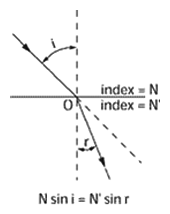
Lens A transparent optical component consisting of one or more pieces of optical glass with surfaces so curved that they serve to converge or diverge the transmitted rays from an object, thus forming a real or virtual image of that object.
Light Electromagnetic radiation detectable by the eye, ranging from 400 to 750nm in wavelength.
Lightning - Most simply defined as the discharge of electricity from one cloud to another, or from a cloud to the ground.
Light dispersion The process by which white light is separated into its component wavelengths. Prisms and gratings are dispersion devices.
Light dispersion
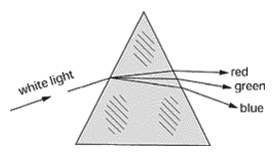
Lightning - Most simply defined as the discharge of electricity from one cloud to another, or from a cloud to the ground.
Liquid crystal A material that possesses less geometrical regularity or order than normal solid crystals, and whose order varies in response to alterations in temperature and other quantities.
Liquid crystal displays A display formed by sandwiching a layer of liquid crystal material between two sheets of glass; a transparent conductive coating on the glass is etched to form character segments. An applied voltage causes the appropriate segments to darken as the liquid crystal changes arrangement.
Lossy A medium that scatters or absorbs radiation that passes through it.
M
Mach-Zender interferometer An interferometer derived from the Twyman-Green interferometer. Light passing through a sample region in one direction recombines with a second leg without traversing the sample twice. The instrument is used to study transparent objects and is particularly useful in studying wind tunnel gas dynamics.
Mach-Zender interferometer
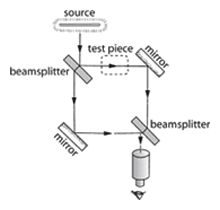
Magnify - To cause an image to appear larger or smaller than the corresponding object. When we look through a lens, we often see things magnified: convex lenses often magnify objects larger, while concave lenses always magnify objects smaller. Mirrors can also magnify objects.
Magnifying power The ability of an optical system to make an object appear larger.
Marginal rays Rays that pass through an optical system near the edge of the aperture.
Maser Microwave Amplification by Stimulated Emission of Radiation. The predecessor of the laser.
Meniscus a lens that has one convex surface and the other is concave.
Meridional ray A ray that lies in the plane that contains the optical axis.
Meter 1) The basic unit of length in the SI system. 2) Any device used for measuring.
Metrology The science of measurement, particularly of angles and lengths.
Microscope An instrument consisting of essentially a tube 160mm long, with an objective lens at the distant end and an eyepiece at the near end. The objective forms a real image of the object in focal plane of the eyepiece where it is observed by the eye. The total magnification is equal to the linear magnification of the objective multiplied by the magnifying power of the eyepiece.
Microscopy - Investigation by means of a microscope.
Mirage The distortion of an objects true image as the result of abnormal atmospheric disturbances along the path traveled by the light.
Mirror A smooth, highly polished surface, for reflecting light that may be plane or curved. The actual reflecting surface is usually a thin coating of silver or aluminum on glass.
Mode 1) The characteristic of the propagation of the light through a waveguide that can be designated by a radiation pattern in a plane transverse to the direction of travel. 2) The state of an oscillating system such as a laser that corresponds to a particular field pattern and one of the possible resonant frequencies of the system.
Modulation Changes in a wave train caused by another wave, such as amplitude or frequency modulation in radio. Is also used to mean contrast when applied to a series of parallel lines ad spaces as imaged by a lens.
Moirι pattern A pattern developed from interference or light blocking when gratings, screens, or regularly spaced patterns are superimposed on one another. When converging lines in the picture are practically parallel to the scanning lines, a moirι pattern will naturally form.
Monochromatic light Light consisting of only one wavelength or a very narrow band of wavelengths.
Monochrometer An instrument for isolating narrow portions of the spectrum by using a prism or grating.
N
Neutral density filter A light filter that decreases the intensity of the light without altering the relative spectral distribution of the energy.
Night-vision device A device that uses low-level visible radiation or IR radiation to produce a visual image of a night scene.
Nodal points The two points at which rays from off-axis object points appear to intersect the axis.
Nodal points
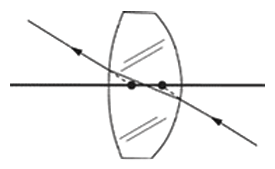
Normal - Perpendicular. If one line is normal to another, then they are at right angles.
O
Object The figure seen through or imaged by an optical system.
Objective The optical element that receives light from the object ad forms the first or primary image in telescopes and microscopes.
Object space The space between the object being viewed and the system entrance pupil.
Optical activity The capacity of a substance to rotate the plane of polarized light that is transmitted through it.
Optical axis The line passing through both the centers of curvature of the optical surfaces of a lens.
Optical fiber - A thin filament of drawn or extruded glass or plastic having a central core and a cladding of lower index of refraction to promote internal reflection.
Optical fiber
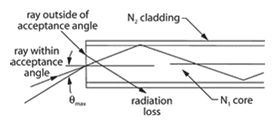
Optical path length The product of the geometrical distance and the refractive index, in a medium of constant index of refraction.
Orthoscopic Corrected for distortion.
Oscilloscope A system in which a supplied signal causes the deflection of the electron beam in a cathode-ray tube, forming a visible trace on the phosphor of the screen of the tube.
P
Parabolic An optic whose surface is in the shape of a parabola.
Parallax The optical phenomenon that causes relative motion between two object points when the eyepoint is moved laterally.
Periodic wave A wave of energy in which each point of the wave is repeatedly displaced at equal time intervals.
Periscope An optical instrument designed to displace the line of sight in a vertical direction. Used often in submarines.
Periscope
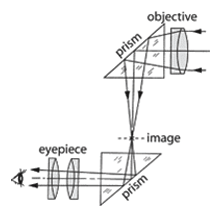
Phase In a periodic function, the segment of the period that has elapsed, measured from some fixed origin.
Photoelectric effect - A phenomenon discovered by Einstein in the early 20th century in which electrons are ejected from a solid when impinged upon by electromagnetic radiation. This led to the understanding of light as particles, or photons. The energy required to strip an electron from an atom is called the ionization energy.
Photography The process of recording of an image on a light sensitive medium.
Photon A quantum of electromagnetic energy of a single mode; a single wavelength, polarization, and direction.
Photonics The technology of generating and harnessing light and other forms of radiant energy whose quantum unit is the photon.
Physical optics The branch of optics which studies interference, diffraction, polarization and other phenomena for which the ray approximation of geometric optics is not valid.
Pinhole camera A lensless camera that uses a small sharp-edged hole as its aperture. The light passed by this aperture onto the cameras film plane produces a soft-edged image that has a wide filed of view, is free form distortion, and exhibits a large depth of field.
Plane A surface that has no curvature.
Planoconcave lens A lens with one plane surface and one concave surface.
Planoconvex lens A lens with one plane surface and one convex surface.
Polarization With respect to light radiation, the restriction of the vibrations of the magnetic or electric field to a single plane. For electromagnetic radiation, the polarization direction is always the direction of the electric field vector. The polarization vector is always perpendicular to the beam direction.
Polarize - To align something in one direction or another. Natural light is a combination of two polarization states. A polarizer can be used to block out one of the polarization states and allowing the other to pass.
Polishing The optical process, following grinding, that puts a highly finished, smooth surface on a lens or mirror.
Power With respect to a lens, it is the reciprocal of the focal length.
Principal plane The surface in a lens or lens system at which the projections of entering and exiting rays intersect.
Principal ray The ray that passes through the center of the pupils of an optical system.
Prism A transparent optical element having at least two polished plane faces inclined relative to each other, from which light is reflected or through which light is refracted.
Proton - One of the elementary particles of nature. The proton has a charge of 1.6 x 10-19 Coulombs and a mass of 1.67 x 10-27 kg, much higher than an electron. The proton resides in the nucleus of an atom, sharing the space with neutrons, neutrally charged particles.
Pupil 1) In the eye, the opening in the iris that permits light to pass and be focused onto the retina. 2) In a lens, the image of the aperture stop as seen from object and image space.
R
Radiation The emission and/or propagation of energy through space or through a medium in the form of either waves of corpuscular emission.
Ray A geometric representation of a light path through an optical device; a line normal to the wavefront indicating the direction of radiant energy flow.
Ray tracing - A process used in optics by which the position and orientation of an image can be established if one knows the focal length of the lens and the position of the object. This process uses strategic rays from the object passing through the lens to locate the image.
Real image - A type of image created by converging light rays. This type of image would form on the image side of a lens, where it could be projected. The opposite of a real image is a virtual image.
Reflect - When light bounces off an object. Usually we associate reflection with a smooth, polished surface; however the surface doesn't have to be smooth. Light reflects off your shirt, therefore others can see that you're wearing one.
Reflectance The ratio of reflected light to incident light.
Reflection The return of radiation by a surface, without change in wavelength. It may be specular from a smooth surface or diffuse from a rough surface, or a combination of the two. The angle of the incident ray is equal to the angle of the reflected ray.
Reflection

Refraction The bending of oblique incident rays as they pass from a medium of one refractive index into a medium of a different refractive index.
Resolution The ability of a lens system to reproduce the points, lines and surfaces in an object as separate entities in the image.
Resonance A large amount of vibration in s system as a result of a small stimulus that has about the same period as the natural vibration period of the system.
Reticle An optical element located at an image plane that contains a pattern that assists in pointing an instrument or measuring target characteristics.
Reticle
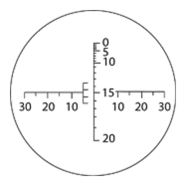
Retina The photosensitive membrane on the inside of the human eye OR a scanning mechanism in optical character generation.
Retroreflection Reflection in which the radiation is returned in directions close to those from which it came.
S
Saturation The decrease of the absorption coefficient of a medium near some transition frequency when the power of the incident radiation near that frequency exceeds a certain value.
Scattering A change of the spatial distribution of a beam of radiation when it interacts with a surface or a heterogeneous medium in which there is no change of the wavelength of the radiation.
Sensitivity The ratio of the output to the input in a radiation detector.
Silicon dioxide Or silica A common optical material from which lenses are made.
Source A physical source of radiation.
Speckle pattern A power intensity pattern produced by the mutual interference of partially coherent beams that are subject to minute spatial and temporal fluctuations.
Spectral Pertaining to or as a function of wavelength.
Spectrum - The result of breaking up light into its various wavelengths.
T
Telecentric lens A lens in which the aperture stop is located at the front focus, resulting in the chief ray being parallel to the optical axis in image space (exit pupil is at infinity).
Telephoto lens A compound lens constructed so that its overall length is equal to or less than its effective focal length.
Telephoto lens
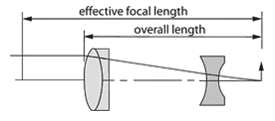
Telescope An afocal optical device that made of lenses and/or mirrors, usually with a magnification greater than unity, that renders distant objects more distinct by enlarging their image on the retina.
Thick lens a lens with an axial thickness adequate to make it producible.
Thin film A thin layer of a substance deposited on an element, often for antireflection, filtering, or polarization effects (among others).
Toric surface A surface that is swept out by revolving a circle about an axis that lies in the plane of the circle but that does not intersect its center.
Transmission The conduction of radiant energy through a medium.
Transparent Capable of transmitting light with little absorption and no appreciable scattering or diffusion.
Transverse Orthogonal to the incoming field.
Twyman-Green interferometer - A testing device that provides a contour map of the emergent wavefront for the observer in terms of the given wavelength of the light.
Twyman-Green Interferometer
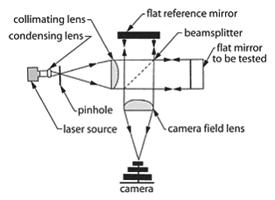
Total internal reflection - A phenomenon occurring when light is incident on an interface between two transparent materials at a very shallow angle. The light must be traveling through a medium with a higher index of refraction than the neighboring medium. At the interface, all of the light is reflected back into the surrounding material and none of the light is refracted out into the neighboring material.
U
Ultraviolet (UV) Wavelengths from 1 - 400nm.
V
Vertex The highest point of a figure or shape.
Visible That pertaining to the spectral region that can be seen by the eye.
Visible spectrum Wavelengths from 400 700nm.
Vitreous That having the characteristics of glass.
W
Watt (W) The power that gives rise to the production of energy at the rate of 1 joule per second.
Wave An undulation or vibration; a form of movement by which all radiant energy of the electromagnetic spectrum is estimated to travel.
Waveguide A system or material designed to confine and direct electromagnetic waves in a direction determined by its physical boundaries.
Wavelength The physical distance covered by one cycle of a wave of electromagnetic energy. Inversely proportional to frequency.
Wave number The frequency of a wave divided by its velocity of propagation; the reciprocal of wavelength.
X
Xerography A printing process of electrostatic electrophotography that uses a photoconductive insulating medium, in conjunction with infrared, visible, or ultraviolet radiation to produce latent electrostatic charge patterns for an observable record.
Z
Zoom To control, by magnifying or reducing, the size of a televised image, either electronically or optically.
Zoom lens An optical system of variable focal length with the focal plane remaining in a fixed position. Some components are moved while others remain stationary.
Zoom lens
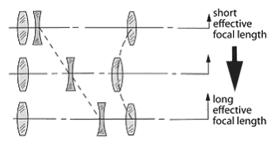
Compiled with help from: Photonics Dictionary, MicroWorlds and OSA Student Chapter Members.










